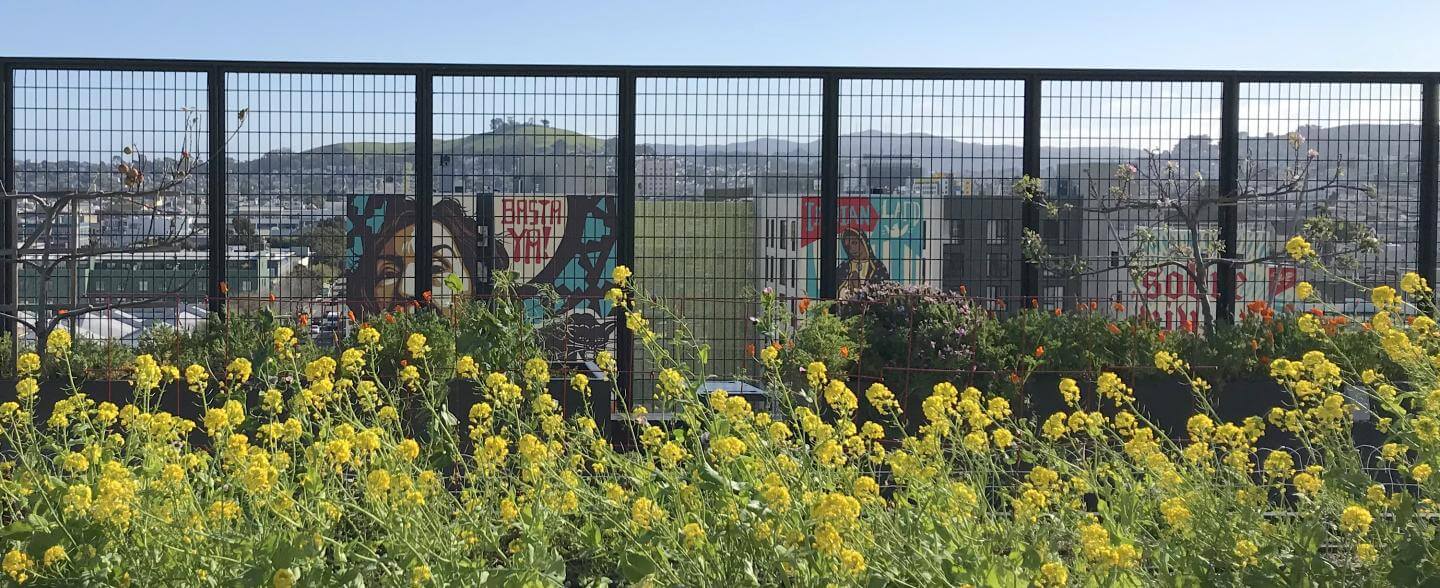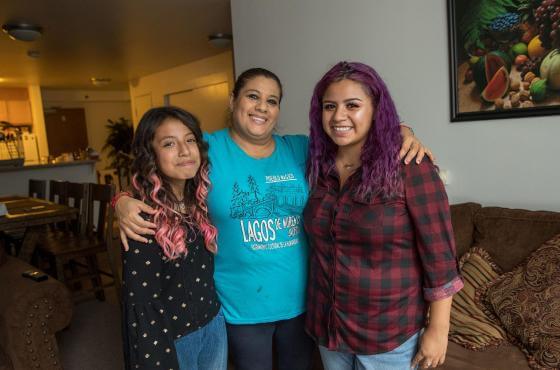Making a dramatic (and wet!) entrance, spring has arrived, and TNDC’s two community gardens and 13 residence gardens (on the rooftops and in the courtyards of our buildings throughout San Francisco) will soon be bustling with unfurling green leaves and buzzing bees, as TNDC’s Urban Agriculture team and our resident and community gardeners prepare for another bountiful year.
Getting Ready for Summer
Over the next few weeks, TNDC’s gardens will be planted with summer crops — the greenhouse at our Webster Street community garden is currently full of seedlings that will be replanted outside as soon as the soil is warm enough, and we’ll be growing a wide variety of delicious produce this year.
TNDC Urban Agriculture Supervisor Julie Pavuk says, “The Bay Area is famous for having many different microclimates, and we have a lot of those just among the TNDC buildings in our various neighborhoods. Even the side of the building you’re on can make a big difference, or whether you’re at street level in the shadow of neighboring buildings or on a rooftop…. For example, in some places we can’t grow tomatoes, and in other places, they grow like gangbusters.”
The gardens are places where a mother can let her young toddler practice walking, where two friends can meet for a leisurely conversation after work, where a teenager can quietly sketch blossoming California poppies, or where any resident can escape to enjoy some sun and a good book.
Climate isn’t the only thing that Pavuk and her colleagues consider when planning TNDC’s gardens. Community input — about the foods that people in a particular building want to eat — also informs these decisions. For instance, last summer at one TNDC building, it was clear that residents preferred large, slicing tomatoes to cherry tomatoes, so this year, Pavuk and her team will be planting more of the former and less of the latter at that building. “I don’t know whether we got that feedback directly,” she says, “but we saw it, so we’re taking that in … this matters, because the gardens are for our community, and we want to make sure that we’re growing what people want.”
Another plant that’s currently getting stronger in our Webster Street greenhouse is new to our gardens: this year, our gardeners will be growing calabacitas, a type of summer squash that’s popular in parts of Mexico, at some of our Mission District buildings. Pavuk explains, “The Mission has historically been home to a large Latine community, and there’s a large indigenous population within that group. We heard that these community members wanted this squash and couldn’t find it … so we were able to get the seeds, and now we’re growing it. It’s something that’s meaningful for our residents, and we’re happy to help provide it.”
Nourishing Community
Urban Agriculture work is housed in our Tenant and Community Services Department and was created to meet our residents’ and community members’ desire for fresh produce, and to fight systemic food inequity in underserved communities. Neighborhoods like the Tenderloin — places where many lower-income people and people of color make their home — have historically been denied access to nutritious foods, which in turn harms residents' physical and mental well-being and prevents them from achieving what they want to achieve in their lives.
With the support of donors, volunteers, and other organizations, TNDC has long been working with our neighbors and in our communities to change that. The nourishing food grown in our community gardens ends up on tables in our buildings and in the wider community. And TNDC’s gardens provide the kinds of green spaces that we all need in order to thrive. Simply having access to a garden can reduce stress levels and improve mental and physical health!
TNDC’s building gardens on rooftops and in courtyards are run in two different ways. Some are portioned out as individual garden plots that residents manage themselves, growing their own food in plot that’s assigned to them — with the support of our Urban Agriculture team (in the form of advice, seeds, and so on). Other gardens are managed with the oversight of the Urban Agriculture team; at those sites, harvesting and distribution of fresh produce is done weekly in the summer and fall, and all of a building’s residents can enjoy the yummy food grown on their building’s roof.
This year, our Urban Agriculture team (which partners closely with TNDC’s Community Organizing team, as well as organizations throughout the city), is looking forward to its strongest year yet, after a couple of slightly scaled-back pandemic years. Pavuk says, “We’ve been working on reestablishing open hours and times for harvesting with tenants and sharing food out, and we’re starting to organize workshops, events, and collaborations with other parts of TNDC. We’re looking for new ways to amplify our impact.”
Blossoming in the Tenderloin
TNDC’s gardens feature raised beds, fruit trees, and even a few flowers, as well as seating areas and gathering spaces for residents and neighbors. And while some residents opt to join the Urban Agriculture team in planting, tending, and harvesting, all residents are welcome to enjoy these beautiful spaces. Pavuk says, “I notice when I’m there and when I’m talking to people how much that space means to community members.” The gardens are places where a mother can let her young toddler practice walking, where two friends can meet for a leisurely conversation after work, where a teenager can quietly sketch blossoming California poppies, or where any resident can escape to enjoy some sun and a good book.
The gardens provide opportunities for people to learn about gardening, nutrition, and more (including cooking classes for kids and adults). They also provide numerous benefits to our city as a whole: rooftop gardens mitigate the urban “heat island” effect, improve air quality, and reduce rainwater runoff.
The Urban Agriculture team is making many changes to broaden the reach of their program’s benefits: They’ve added Saturdays to the schedules of their urban agriculture coordinators, so that more school-age kids and people with Monday–Friday work schedules can get involved. And the Urban Agriculture team is working with TNDC’s Healthy Aging program to bring senior citizens from TNDC buildings to the Tenderloin People’s Garden or, if senior residents are unable to visit a garden, to bring some garden-type activities to them!
Pavuk says, “We’re still in the process of brainstorming how we can be available to more of our community, and I’m really excited about finding ways to do that.”
If you’re interested in learning more about our Urban Agriculture program, or would like to learn more about how you can support TNDC, visit TNDC’s Urban Agriculture page.


